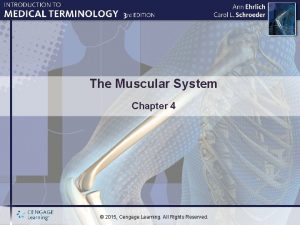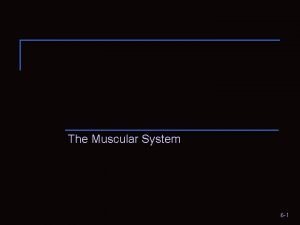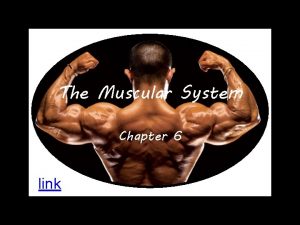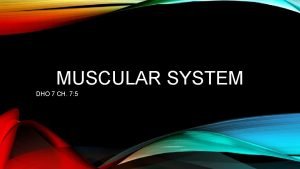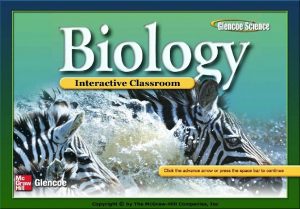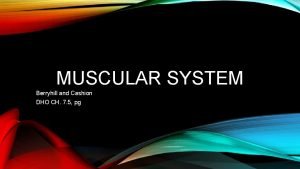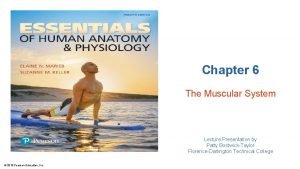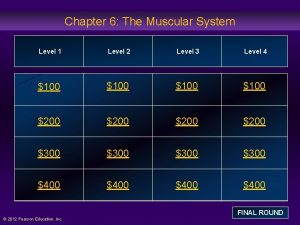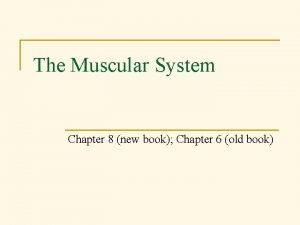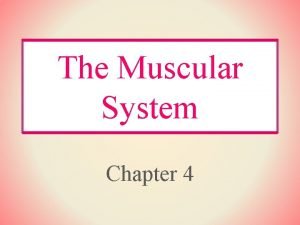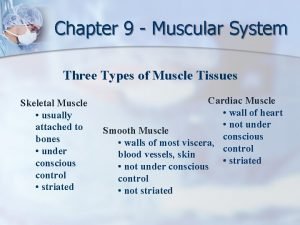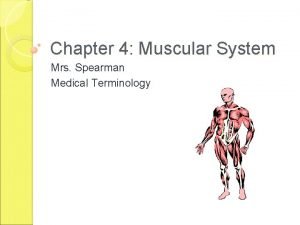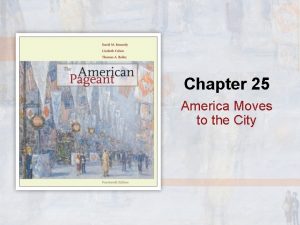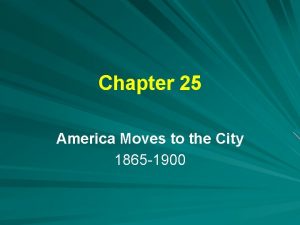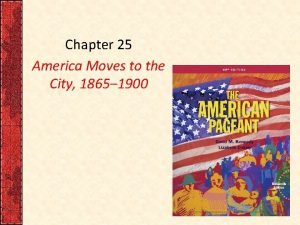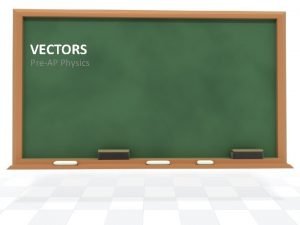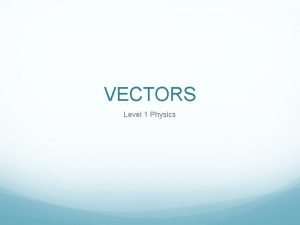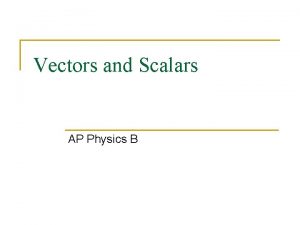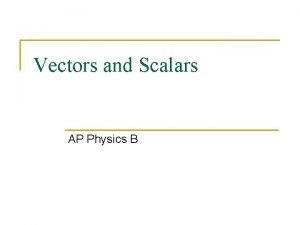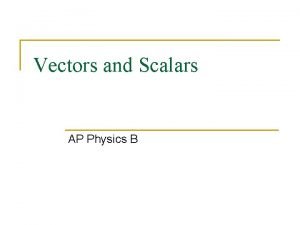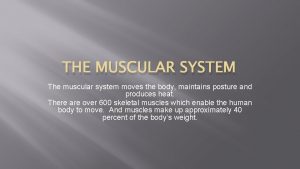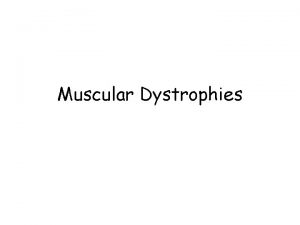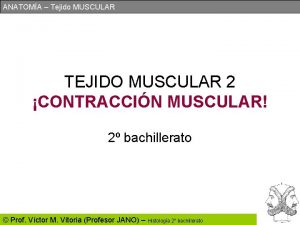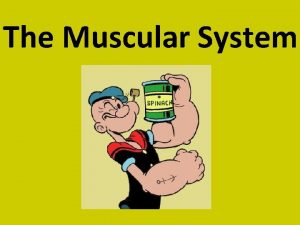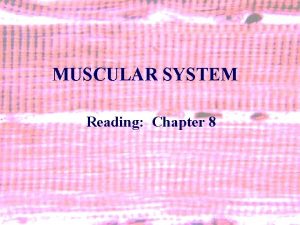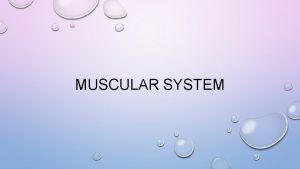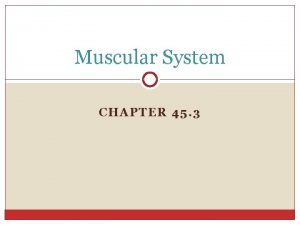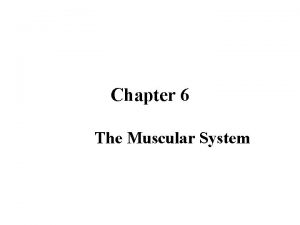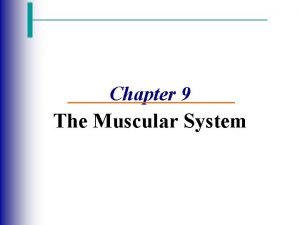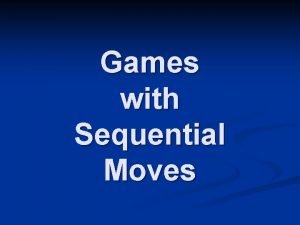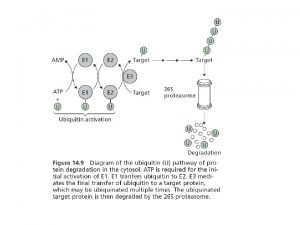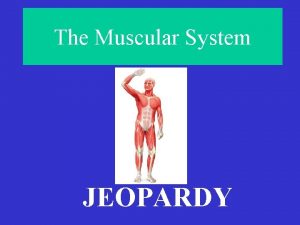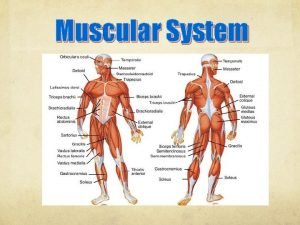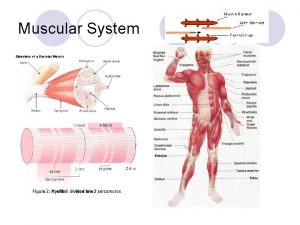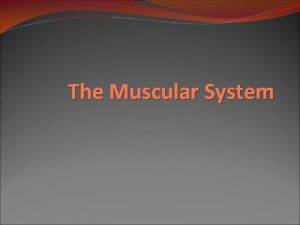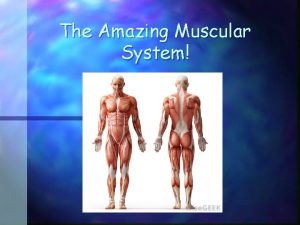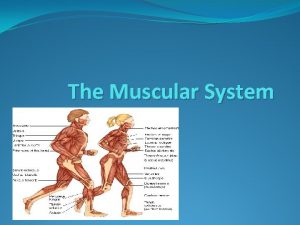Chapter 9 Muscular System The Muscular System Moves




















































- Slides: 52

Chapter 9 -Muscular System

The Muscular System Moves Body Parts and Maintains Posture • The muscular system produces movement and maintains posture • There are three types of muscles: skeletal, cardiac, and smooth • All muscles are excitable, contractile, extensible, and elastic – – Excitable: respond to stimuli Contractile: shorten Extensible: stretch Elastic: return to their original length after being shortened or stretched


Skeletal Muscles Work in Pairs • Skeletal muscles are voluntary muscles responsible for moving our body • Each muscle is attached to a bone by a tendon • The origin of the muscle remains stationary during movement while the insertion is attached to the bone that moves • Most muscles are arranged in pairs, called antagonistic pairs, that work in opposition to one another



Sacromeres Are the Contractile Units of Muscle • When skeletal muscles are viewed under a microscope, they have distinct bands called striations – They are formed by the arrangement of myofibrils within the muscle cell • Each myofibril contains groups of long myofilaments • Each myofilament is composed of myosin and actin filaments





Sarcomeres • Sarcomeres are the contractile units of muscle – They shorten as the actin filaments slide along the myosin filaments • Muscle contraction occurs at the molecular level • According to the sliding filament model, muscle contracts when actin filaments slide past myosin filaments







Sarcomeres • The myosin head attaches to the actin filament forming a cross bridge – Then it bends and swivels, pulling the actin filament toward the midline of the cell • The tropomyosin-troponin complex and calcium ions regulate muscle contraction at the actinmyosin binding sites • Contraction is triggered when a nerve impulse travels down a motor neuron until it reaches the neuromuscular junction




Sacromeres • At the neuromuscular junction it causes the release of acetylcholine from vesicles in the motor neuron • The acetylcholine causes changes in the permeability of the muscle cell, resulting in an electrochemical message similar to a nerve impulse

Muscle Contraction Depends on the Stimulation of Motor Units • A motor neuron and all the muscle cells it stimulates are called a motor unit • The strength of muscle contraction depends on the number of motor units that are stimulated • The muscle cells of a motor unit are spread throughout the muscle resulting in even, whole muscle contraction


Myofibril Contains protein filaments – ACTIN (thin) and MYOSIN (thick) These filaments overlap to form dark and light bands on the muscle fiber § A band = d. Ark • thick (myosin) § I band = l. Ight • th. In (actin) In the middle of each I band are Z lines. A sarcomere is on Z line to the other •




myosin It is important to remember the heirarchy myofibrils fasicles myofilaments actin

It is important to remember the heirarchy fasicles myofibrils myofilaments actin myosin

muscle fiber myofilament epimysium muscle myofibrils sarcomere

myofilament muscle sarcomere epimysium myofibrils muscle fiber



Muscles & Nervous System

Motor Unit or Neuromuscular Junction 1. Neuron 3. Vesicle 2. Sarcolemma (or motor end plate) 4. Synapse 5. Mitochondria

The neurotransmitter that crosses the gap is ACETYLCHOLINE. This is what activates the muscle. Acetylcholine is stored in vesicles

Motor Unit The muscle fiber and the motor neuron


SLIDING FILAMENT THEORY (MODEL) The theory of how muscle contracts is the sliding filament theory. The contraction of a muscle occurs as the thin filament slide past the thick filaments. The sliding filament theory involves five different molecules plus calcium ions. The five molecules are: myosin actin tropomyosin troponin ATP

Sliding Filament Handout

Sliding Filament Handout

ANIMATION OF SLIDING FILAMENT http: //www. blackwellpublishing. com/matthews/myosin. html

Muscle Stimulation Increases the Strength of Contraction • All of the muscle cells innervated by a single neuron contract at once causing a muscle twitch • If a second stimulus is received before the muscle is fully relaxed, the second twitch will be stronger than the first due to wave summation • Taken to the extreme, a sustained powerful contraction is called tetanus • Fatigue sets in when a muscle is unable to contract even when stimulated



ATP for Muscle Contraction Comes from Many Sources • The ATP for muscle contraction comes from many sources • The initial source is the ATP stored in the muscle cells and then the ATP formed from the creatine phosphate reserves • When those sources are depleted, the muscles depend upon stored glycogen, which is converted to glucose and then to ATP through aerobic respiration or lactic acid fermentation


Slow-Twitch and Fast-Twitch Muscle Cells Differ • Slow-twitch cells are loaded with mitochondria and therefore deliver prolonged, strong contractions • Fast-twitch cells contract rapidly and powerfully but with much less endurance. They rely on lactic acid fermentation as their source of energy and therefore tire quickly


Aerobic Exercise; Resistance Exercise • Aerobic exercise increases endurance and coordination • Resistance exercise builds strength
 Plyometrics disadvantages
Plyometrics disadvantages Chapter 4 the muscular system labeling exercises
Chapter 4 the muscular system labeling exercises Unit 6:5 muscular system
Unit 6:5 muscular system The muscular system chapter 6
The muscular system chapter 6 Chapter 6 the muscular system figure 6-12
Chapter 6 the muscular system figure 6-12 7:5 muscular system
7:5 muscular system Aerobic respiration exercise
Aerobic respiration exercise Chapter 32 section 3 the muscular system answer key
Chapter 32 section 3 the muscular system answer key Microscopic anatomy of skeletal muscle figure 6-2
Microscopic anatomy of skeletal muscle figure 6-2 Chapter 7:5 muscular system
Chapter 7:5 muscular system Chapter 6 the muscular system
Chapter 6 the muscular system Cengage chapter 4 answers
Cengage chapter 4 answers Chapter 6 the muscular system
Chapter 6 the muscular system Chapter 6 the muscular system
Chapter 6 the muscular system Chapter 10 the muscular system
Chapter 10 the muscular system Chapter 8 the muscular system
Chapter 8 the muscular system The muscular system chapter 4
The muscular system chapter 4 Sarcromeres
Sarcromeres The medical term for hiccup is _____.
The medical term for hiccup is _____. Chapter 16 section 4 america moves toward war
Chapter 16 section 4 america moves toward war Chapter 24 section 4 america moves toward war
Chapter 24 section 4 america moves toward war Chapter 25 america moves to the city
Chapter 25 america moves to the city Chapter 25 america moves to the city
Chapter 25 america moves to the city Chapter 25 america moves to the city
Chapter 25 america moves to the city A bear searching for food wanders 35 meters east
A bear searching for food wanders 35 meters east A storm system moves 5000 km due east
A storm system moves 5000 km due east A storm system moves 5000 km due east
A storm system moves 5000 km due east A storm system moves 5000 km due east
A storm system moves 5000 km due east A storm system moves 5000 km due east
A storm system moves 5000 km due east A bear searching for food wanders 35 meters east
A bear searching for food wanders 35 meters east Hình ảnh bộ gõ cơ thể búng tay
Hình ảnh bộ gõ cơ thể búng tay Slidetodoc
Slidetodoc Bổ thể
Bổ thể Tỉ lệ cơ thể trẻ em
Tỉ lệ cơ thể trẻ em Gấu đi như thế nào
Gấu đi như thế nào Thang điểm glasgow
Thang điểm glasgow Hát lên người ơi
Hát lên người ơi Các môn thể thao bắt đầu bằng tiếng chạy
Các môn thể thao bắt đầu bằng tiếng chạy Thế nào là hệ số cao nhất
Thế nào là hệ số cao nhất Các châu lục và đại dương trên thế giới
Các châu lục và đại dương trên thế giới Cong thức tính động năng
Cong thức tính động năng Trời xanh đây là của chúng ta thể thơ
Trời xanh đây là của chúng ta thể thơ Cách giải mật thư tọa độ
Cách giải mật thư tọa độ 101012 bằng
101012 bằng Phản ứng thế ankan
Phản ứng thế ankan Các châu lục và đại dương trên thế giới
Các châu lục và đại dương trên thế giới Thơ thất ngôn tứ tuyệt đường luật
Thơ thất ngôn tứ tuyệt đường luật Quá trình desamine hóa có thể tạo ra
Quá trình desamine hóa có thể tạo ra Một số thể thơ truyền thống
Một số thể thơ truyền thống Cái miệng nó xinh thế chỉ nói điều hay thôi
Cái miệng nó xinh thế chỉ nói điều hay thôi Vẽ hình chiếu vuông góc của vật thể sau
Vẽ hình chiếu vuông góc của vật thể sau Thế nào là sự mỏi cơ
Thế nào là sự mỏi cơ đặc điểm cơ thể của người tối cổ
đặc điểm cơ thể của người tối cổ

